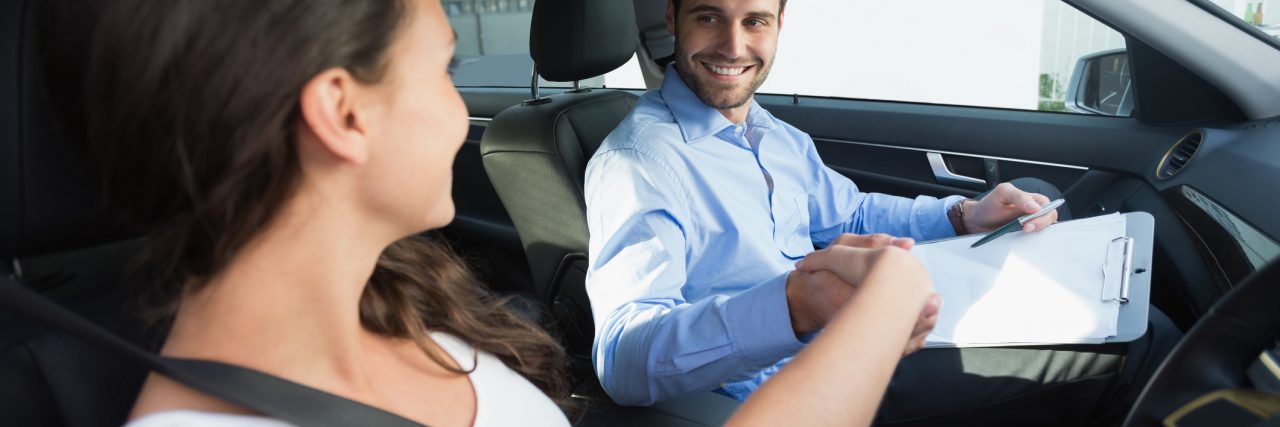For many people their 17th birthday means more independence, and learning to drive is at the top of the list. For someone with a physical disability this is no different. For many people with physical disabilities, independence feels even more important; perhaps this is why I crave independence and strive to achieve my very best.
To learn to drive, the first thing I had to do was to apply for my provisional driving license. I filled in the form as usual, the only extra thing I had to do was visit my general practitioner who the driving license agency contacted for information about my condition.
When I got my provisional driving license I was advised by the driving license agency to have a driving assessment at one of their assessment centers. I knew that if I was told I couldn’t drive I would have to accept it, and as my condition doesn’t change, a no would be a permanent no. I remember feeling nervous but trying so hard to keep calm. A driving instructor and occupational therapist carried out the assessment, which included them talking to me about my disability, what movement I had, a startle reaction test and if I had any driving experience. I had some experience thanks to me dad letting me drive his car around a field.
After this, I was allowed to go for a drive; it was both even exciting and scary. I had a driving instructor, an occupational therapist and I asked my dad to come with me. I drove around the industrial estate; I had thought it would be an off road but no, I actually drove on a road. After some static practice of changing gears it was time to drive. I was told what to do by the instructor with the occupational therapist assessing if I could safety control the vehicle. I drove around, did some steering around posts, then it was time to go back for the debrief. I remember them staying that I should book some lessons. The recommendations were that I should try a few lessons to see how I managed. They also suggested an easy-release hand brake and a seat belt extension, although in my own car I do not have these as when nobody is watching me I can do the seat belt, and only have a problem with the hand brake if someone borrows my car.
As soon as the report arrived I booked my first lesson. The report recommended driving instructors; I chose one and stayed with the same person. To be honest, I didn’t really enjoy my first few driving lessons. There seemed to be so much to remember and do all at the same time. Some lessons I really enjoyed and felt like I was making progress; others I felt like I was never going to get it. However, the more lessons I had, the more I enjoyed them and the more confident I became.
After about a year or so I decided to buy my own car so I could get more practice. This really helped, although it can be difficult switching between two cars. After failing my second test and discussion with my instructor I decided to just drive my own car for all my lessons. I passed my test fourth time around on March 14, 2011. I don’t remember the whole test route. I had the option of having my instructor sit in the car; I didn’t do this on my first two test, but the next two I did. I think it’s good to have your instructor in the car, as if you don’t pass your driving instructor will know the areas you need to practice. The one thing I did differently was most instructors recommend a two-hour driving lesson first, but as my cerebral palsy means I use two to three times more energy, it was better to have a short practice and break before taking my test.
After passing my test I drove on my own as soon as possible. I started with short familiar routes, gradually building up my confidence. After about a year I changed my car. When I bought both of my cars, the most important aspect was the driving position. For me personally, I like to sit high. Only you can decide the best driving position for you, so try options until you feel comfortable. It’s difficult when you’re learning in an instructor’s car; you have to change the seat, steering wheel and mirrors. It can take a while to find the best setup, but remember when your have your own can you won’t have to keep changing it.
If you use a wheelchair or other walking aid, ensure you can easily fit your chair or walking aid in your vehicle. I bought the car then tried to find a chair to fit the car. I found one in the end, but I would carefully consider the size of the car if you use a walking aid or wheelchair. If you are in the U.K. and receive Disability Living Allowance or Personal Independence Payment, you can use part of your allowance to lease a car. For me it worked out better to buy my car and use my allowance to run the car.
I have now been driving for six years and I love the independence driving has given me. If you are reading this and have a physical disability, I would encourage you to take the first steps to getting on the road.
We want to hear your story. Become a Mighty contributor here.
Thinkstock photo by Wavebreak Media.
Originally published: April 10, 2017

